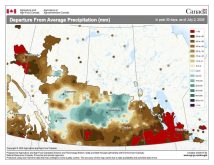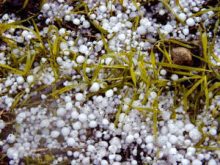Let’s look at what is probably the most feared and costly summer severe weather event: hail.
How expensive can hail be? To put it into perspective, on June 13, 2020, a severe hailstorm hit Calgary, causing an estimated $1.2 billion in insurance damage, which ranks as one of the top five most expensive natural disasters in Canada.
While hail can occur almost anywhere across North America, there are two main regions where the chances of a hailstorm are significantly higher. The first is the central United States, extending northwards into extreme southern Ontario. The second is the Canadian Prairies, Alberta in particular.
Read Also

Thunderstorms and straight-line winds
Straight-line winds in thunderstorms can cause as much damage as a tornado and are next on our weather school list exploring how and why severe summer weather forms.
Before we dive into the how and why of hail, I have to air another weather peeve of mine – its definition.
Hail refers to the falling of ice from a cumulonimbus (thunderstorm) cloud. Ice pellets, snow pellets and graupel (a snowflake that has been coated in ice) are not hail and should not be called hail. These cases of mistaken identity will often occur in the spring or late fall and are not associated with thunderstorms. You need to have a thunderstorm for hail to occur.
One of the first questions I get asked about hail is, can it be too warm for hail? The answer is yes.
If the upper atmosphere is warm, the freezing level in the atmosphere is very high up. If a thunderstorm does develop, and if hail forms in the storm, chances are that the hail will not be able to get very big and will melt before it reaches the ground.
The key ingredients for hail to form are plenty of cold air aloft and but not too high off the ground. This is one reason Alberta and the higher elevation of the American Midwest experience more hail. The higher elevation often means the freezing layer is lower to the ground, with a greater chance that hail will not melt before reaching the surface.
Most thunderstorms will produce hail. The question is whether the hail will grow large enough to reach the ground without melting.
As we have discussed, a very low freezing level helps this happen, since the hailstone only has a short distance to fall through the relatively warm air. Another way to keep a hailstone from melting is to have a really big hailstone.
Here lies a second common misconception about thunderstorms and hail. To get really big hailstones, you do not necessarily need a really tall (or high) thunderstorm.
Hail forms when a particle passes from the warm (liquid) part of the cloud into the cold (freezing) part of the cloud. When this occurs, any water on the particle freezes and you have a small hailstone.
Now, if that hailstone just kept going up toward the top of the thunderstorm, it wouldn’t accumulate much more ice and therefore would remain small.
For hailstones to get really big, they must go back into the warm (liquid) section of the storm, pick up more water, then go back up into the cold section of the cloud so the water can freeze.
Repeat this cycle several times and you get some really big hailstones.
Sometimes, hailstones can hit each other and freeze together, creating a conglomerate hailstone. Picture a popcorn machine or, better yet, an old-fashioned bingo machine. The balls, or hailstones, are continually moving up and down due to the strong updraft. Eventually either the hailstone will get too big to be supported by the updrafts, the updrafts weaken or they end up in part of the storm that no longer has updrafts. They then fall.

When it comes to hail, size really does matter. Pea-sized hail will do little if any damage to structures or plants, while golf-ball sized hail can destroy everything in its path.
When it comes to measuring hailstone size, things become a little strange. You don’t usually hear that the hail will be around 50 millimetres in diameter. Instead, you hear the hail was the size of a golf ball or an egg.
Of all the things we measure in weather, hail has by far the most descriptive measurements. Here are some of the more common descriptive terms used for hail and the approximate size the hailstone would be.
So far this summer, while there have been some reports of hail, I haven’t seen or heard about any significant or large hailstorms. Let’s hope that continues for the rest of the summer.




















